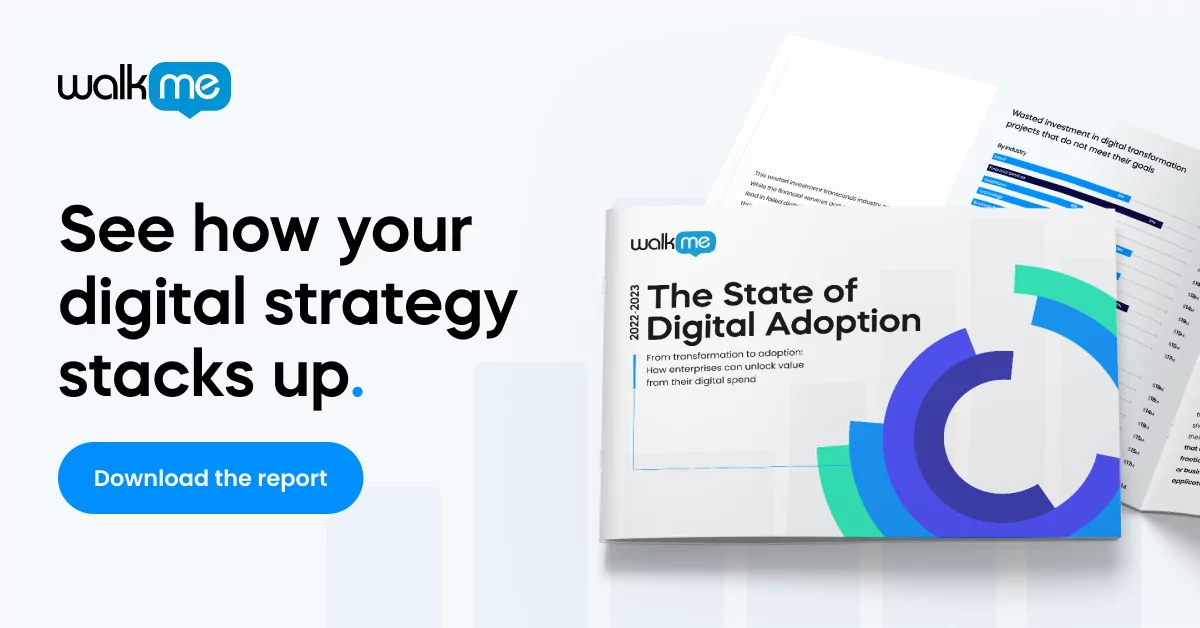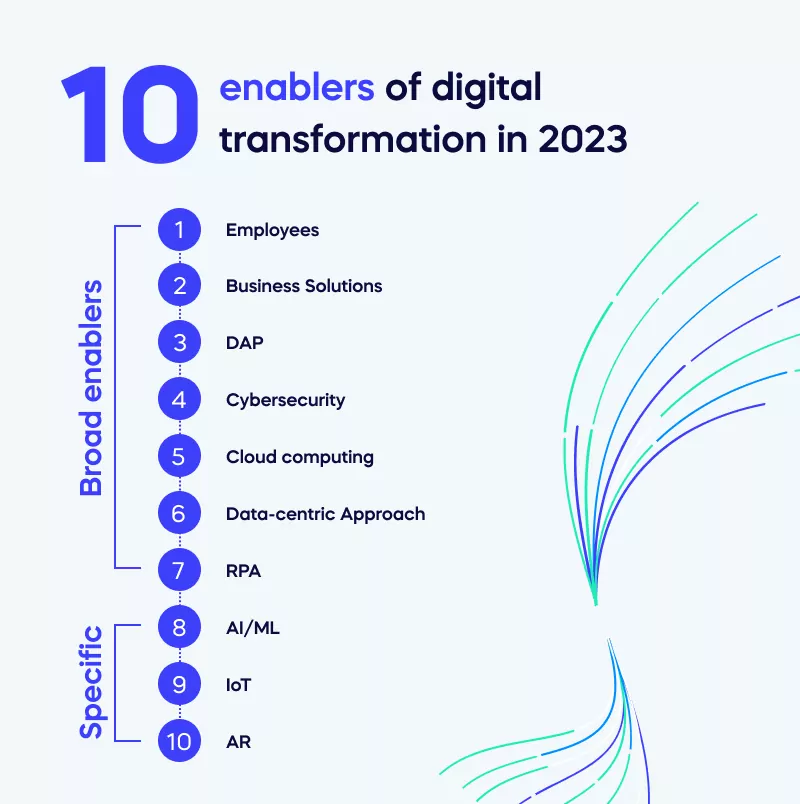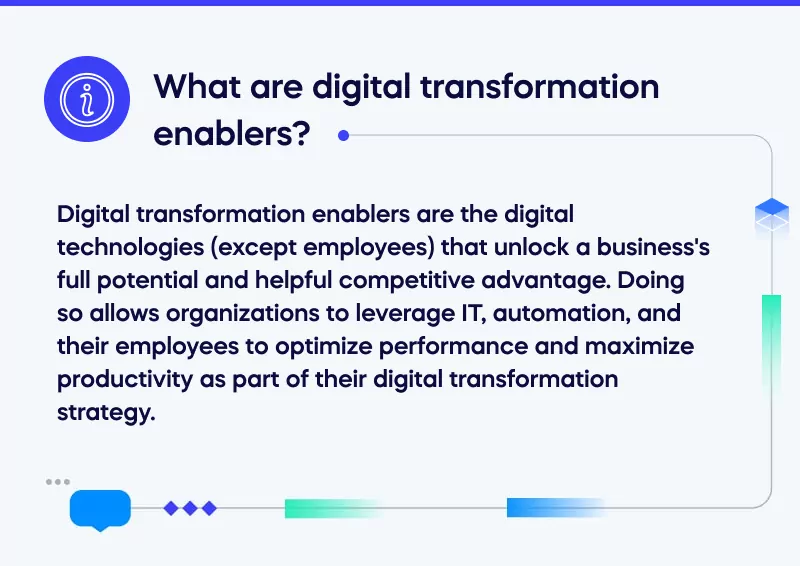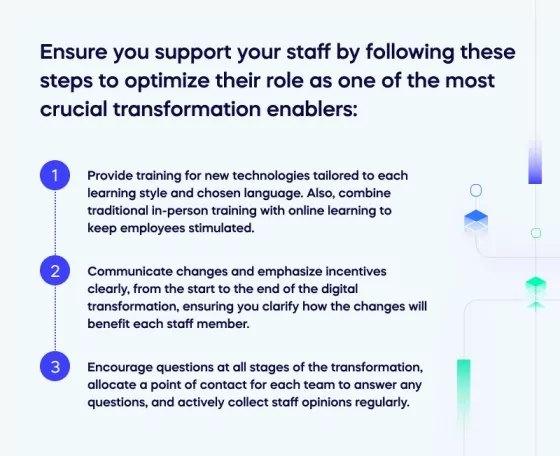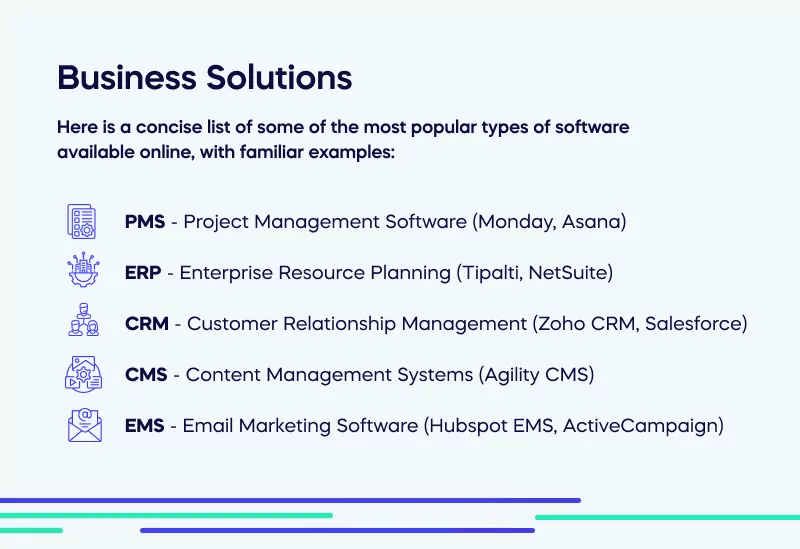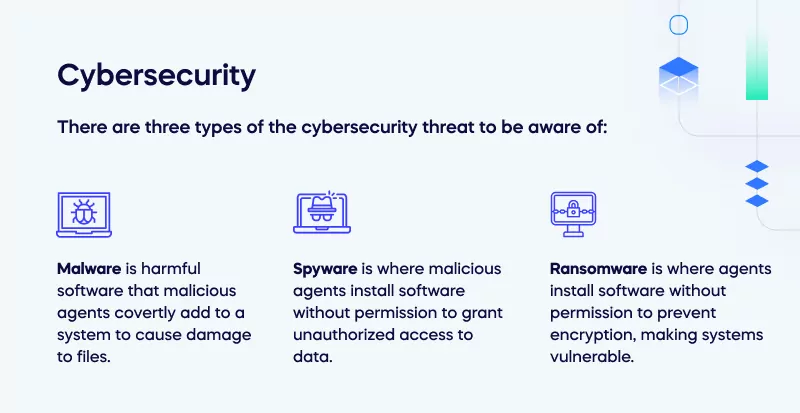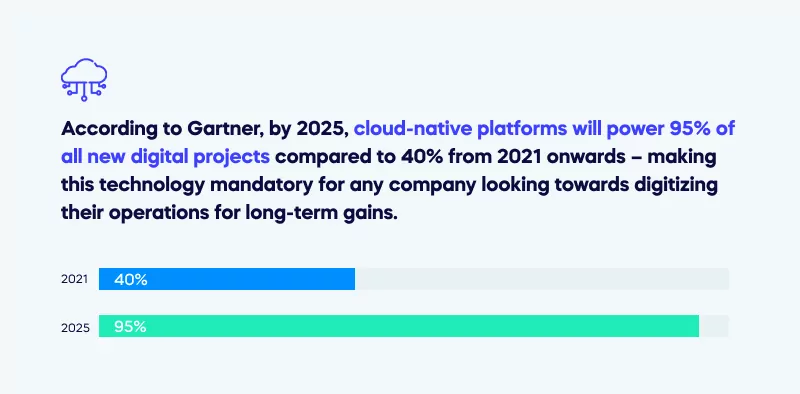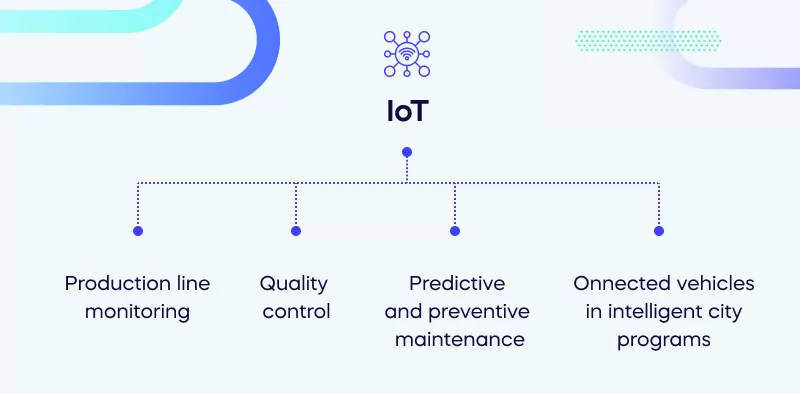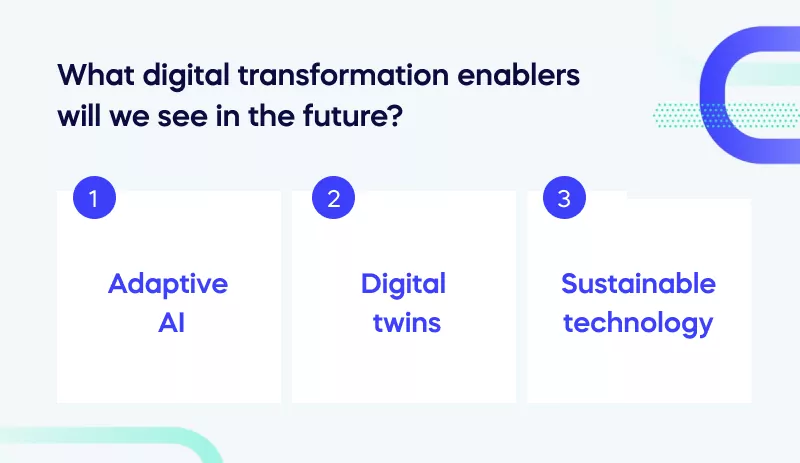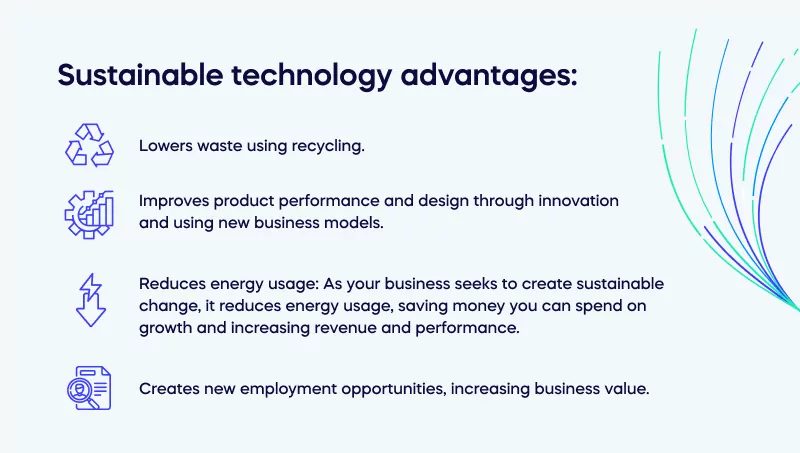We have compiled a list of the ten most useful digital transformation enablers you will ever need. Below, we describe these enablers to help your entire organization succeed.
In priority order, the ten enablers of digital transformation are:
-
Employees
-
Business solutions
-
DAP (digital adoption platform)
-
Cybersecurity
-
Cloud computing
-
A data-centric approach
-
RPA (robotic process automation)
-
AI/ML (artificial intelligence/ machine learning)
-
IoT (Internet of Things)
-
AR (augmented reality)
But before we look at each enabler in detail, let’s begin by defining what enablers are.
What are digital transformation enablers?
Digital transformation enablers are the digital technologies (except employees) that unlock a business’s full potential and helpful competitive advantage. Doing so allows organizations to leverage IT, automation, and their employees to optimize performance and maximize productivity as part of their digital transformation strategy.
You can apply enablers to improve your business regardless of your product or service. Whether you sell soft drinks or SaaS services, enablers support a successful transformation. However, not every enabler is relevant to every business, so make your technology choices carefully, following planning and research to ensure they will provide the best operational efficiency.
Now that we understand digital transformation enablers let’s look at how they are essential to the business world.
Why are digital transformation enablers essential for businesses?
As technological advancement intensifies, CEOs and CIOs become more aware of their need to remain at the cutting edge of technology to remain competitive. When tech leaders utilize the best enablers for their organization, they leverage the appropriate tools and technologies and experience transformative results.
These results are often more efficient operations that empower companies to respond rapidly to customer demand while building efficient workflows that create a strong foundation for growth and success. Enablers also help support each of the four main areas of digital transformation.
We see an example with Paychex, a leading payroll and HR solutions company. Confronted with a significant migration from Salesforce Classic to Salesforce Lightning app development software, the Paychex team had to find an efficient change management solution.
WalkMe supported Paychex to streamline the transition to the Lightning software, delivering tailored in-app guidance. Doing so ensured the company maintained accuracy and productivity at all times. Thanks to WalkMe, over three thousand sales reps could use the new software within six months.
In this example, a DAP was the digital transformation enabler that helped a large organization complete a successful transformation.
Now that we have covered why businesses need to enable digital transformation, we can look at each enabler in detail.
The ten enablers of digital transformation in 2023
To demonstrate the importance of the ten enablers of digital transformation in 2023, we have separated them into broad enablers, which apply to every industry, and specific enablers, which only use the specified drives.
Broad enablers
Broad digital transformation enablers apply to every business and include:
-
Business Solutions
-
Employees
-
DAPs (digital adoption platforms)
-
Cybersecurity
-
Cloud computing
-
A data-centric approach
-
RPA (robotic process automation)
The highest priority enabler from this list is business solutions, as they apply to every business process in every organization and are, therefore, the priority for optimization as part of your digital transformation.
1. Employees
Although technologies form an essential part of your digital transformation, your employees are responsible for their successful application in your business. Ensure you support your staff by following these steps to optimize their role as one of the most crucial transformation enablers:
-
Provide training for new technologies tailored to each learning style and chosen language. Also, combine traditional in-person training with online learning to keep employees stimulated.
-
Communicate changes and emphasize incentives clearly, from the start to the end of the digital transformation, ensuring you clarify how the changes will benefit each staff member.
-
Encourage questions at all stages of the transformation, allocate a point of contact for each team to answer any questions, and actively collect staff opinions regularly.
Following these steps will make your staff feel listened to, and valued, ensure buy-in, and increase retention, increasing your chances of a successful transformation.
2. Business Solutions
Staying up-to-date with cutting-edge technology is essential to remain successful in the digital era. Business solutions offer your business a range of software tools and applications that allow you to create new products and services, oversee your personnel, automate mundane daily tasks, and much more. Utilizing these resources can give your digital business an advantage over competitors still using legacy systems.
Regarding business solutions, the choices of digital technology are endless. From digital and mobile applications to web-based and even desktop apps – you can find whatever works best for your company. Here is a concise list of some of the most popular types of software available online, with familiar examples:
1. PMS – Project Management Software (Monday, Asana)
2. ERP – Enterprise Resource Planning (Tipalti, NetSuite)
3. CRM – Customer Relationship Management (Zoho CRM, Salesforce)
4. CMS – Content Management Systems (Agility CMS)
5. EMS – Email Marketing Software (Hubspot EMS, ActiveCampaign)
Always define your needs beforehand when choosing a new business solution to ensure you get the right tool for the function and the optimal ROI.
3. DAP
It is important to remember that adoption and transformation are two halves of the same coin in helping you to transform your business processes. Digital adoption involves training and acquiring employee buy-in that allows the digital transformation to become successful. DAPs are one of the most effective ways to enable digital transformation.
Because of digital adoption and transformation, solutions like our market-leading DAP are high-priority broad transformation enablers. DAPs utilize in-app guidance to train your employees without manual training, enabling a successful digital transformation and cementing their place as one of your tech stack’s most valuable digital tools.
4. Cybersecurity
As much as we would prefer to live in a safe business environment, the risks of having data damaged or stolen are everywhere, making cybersecurity high on the list of transformation enablers. There are three types of the cybersecurity threat to be aware of:
-
Malware is harmful software that malicious agents covertly add to a system to cause damage to files.
-
Spyware is where malicious agents install software without permission to grant unauthorized access to data.
-
Ransomware is where agents install software without permission to prevent encryption, making systems vulnerable.
Consider your company’s risk level from each type of security attack when selecting your cybersecurity software and specialists for a successful digital transformation free of delays and disruptions.
5. Cloud computing
Cloud adoption has risen dramatically in the past few years. It is still on an upward trajectory with the widespread use of cloud-native apps, partly due to the accelerated digital transformation that came with the Covid-19 pandemic.
With digital tools such as Software as a Service (SaaS), Platform as a Service (PaaS), and Infrastructure as a Service (IaaS), businesses have been able to be more agile, launch products faster, reduce time-to-market expenses, and remove the complexity of managing IT.
According to Gartner, by 2025, cloud-native platforms will power 95% of all new digital projects compared to 40% from 2021 onwards – making this technology mandatory for any company looking towards digitizing their operations for long-term gains.
6. Data-centric Approach
Unlike human-based decision models, a data-centric approach uses the best available data to create powerful and efficient machine learning systems. Rather than devoting energy to constructing intricate models, this method aims to assemble high-quality datasets to strengthen decisions in business.
7. RPA
Robotic process automation (RPA) is a revolutionary software technology that simplifies the development, deployment, and management of bots that imitate human activities while interacting with digital systems. RPA allows you to easily automate mundane tasks without costly and time-consuming operation changes – saving money and effort in the long run.
Now we have looked at the enablers of digital transformation in 2023, let’s consider what our tech stack will look like beyond this year.
Now that we have looked at some broad enablers that apply to all businesses, let’s examine some specific enablers that only apply to particular industries.
Specific enablers
Specific digital transformation enablers only apply to particular businesses as they serve more specialized functions and include:
-
AI/ML (artificial intelligence/ machine learning)
-
IoT (Internet of Things)
-
AR (augmented reality)
8. AI/ML
Thanks to the revolutionary emergence of artificial intelligence and machine learning, businesses can collect unprecedented insights into customer behavior. Doing so allows them to provide technologies suited to retail and sales, giving shopping recommendations and automated customer services/chatbots, image & speech recognition tech, and drone surveillance – you name it, AI and ML can do it.
These modern advances equip organizations with valuable data that power strategic decisions for successful outcomes in a rapidly changing landscape.
9. IoT
With IoT devices providing real-time data collection, opportunities are endless. IoT solutions have revolutionized numerous industries. Examples include production line monitoring, quality control, predictive and preventive maintenance, and connected vehicles in intelligent city programs. Discovering new use cases for IoT is only limited by our creativity and imagination.
10. AR
Augmented reality and virtual reality are revolutionary technologies that provide an unprecedented level of immersion when interacting with digital content, granting users a virtual experience that is indistinguishable from reality. Through sophisticated software and hardware, AR enables individuals to immerse themselves in lifelike simulations and interact with them just as they would in the real world.
Companies leverage VR in many business tech spaces, from gaming to cinema, media, and telecommunications to industrial design and manufacturing. It’s an effective tool for showing a product or service before purchase, transforming education, medicine, and architecture.
However, despite the importance of investing in transformation enablers for 2023, it’s also helpful to constantly research the following essential enablers.
What digital transformation enablers will we see in the future?
The constantly shifting nature of digital transformation enablers means that looking to the future to see what technologies you must invest in to stay ahead of your competitors is essential.
Adaptive AI
By using a sequence-based data analysis instead of the conventional simultaneous gathering and processing method, Adaptive AI allows for unparalleled learning speed. The reason is that the system can receive large amounts of real-time feedback from new experiences while simultaneously working on previous predictions. As such, it’s no surprise that this unique approach has allowed businesses to operate at an unprecedented pace with increased accuracy.
Digital twins
By providing a virtual representation of an asset, system, or process in real-time, digital twins enable organizations to make informed decisions by analyzing data from the physical world. Doing so helps them reduce costs, improve efficiency and enhance user experience.
Digital twins are becoming increasingly popular as they provide instant insights into how different components interact with each other while at the same time ensuring that those interactions remain secure. With its ability to monitor systems more efficiently than ever, this technology will undoubtedly revolutionize many industries, becoming a critical digital transformation enabler over the coming years.
Sustainable technology
Digital transformation is about looking to the future. We must identify and utilize the most sustainable technologies to secure the future of the planet and every business within it to ensure our survival.
Sustainable technology is a term that encompasses technologies that promote economic and social progress while also preserving natural resources. These advances have the ultimate mission of significantly decreasing environmental dangers and producing sustainable products and have many advantages to business processes, which are listed below.
-
Lowers waste using recycling.
-
Improves product performance and design through innovation and using new business models.
-
Reduces energy usage: As your business seeks to create sustainable change, it reduces energy usage, saving money you can spend on growth and increasing revenue and performance.
-
Creates new employment opportunities, increasing business value.
All of these points show that sustainable technology isn’t just for the environment; it’s for the growth and success of your company, as resource savings for the planet mean cost savings and more investment for innovation for your organization.
Prioritize the most important transformation enablers: your employees
When you hear ‘digital transformation enablers,’ you might think of one of the technologies listed above. But, prioritizing technology over your employees can lead to the failure of your digital transformation efforts and poor business outcomes.
Always remember that organizations are composed of individuals and people learning to use new technologies. Digitalization efforts are complex and emotionally demanding processes of change that often lead to resistance.
However, when you support your staff in the ways they find meaningful, they will be more likely to enable the most successful digital transformation your organization has experienced, securing digital resilience for your company for many years.
